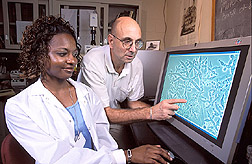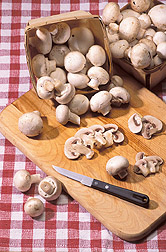A Mushroom Mystery:
|
|
 Mycologist Gary Samuels and University of Maryland student Lutorri Ashley discuss the morphology of the Trichoderma that causes green mold of mushrooms. (K10099-1) |
In early spring, after winter-dormant fields have been tilled and seeded, farmers walk over their fields and look for signs of life. They scan the newly furrowed earth for tiny shoots of green and give a small sigh of relief when they find them. Most farmers, that is. If there's one thing a farmer of mushrooms fears, it's seeing the color green in his or her crop beds. Mushrooms are fungi and lack chlorophyll. Instead of relying on the sun and photosynthesis, they draw their nutrients from the ground and their growing medium. Healthy colors for the most popular commercially grown mushrooms in the United States are white, brown, and beige. Green spells disease. For mycologists with the Agricultural Research Service's Systematic Botany and Mycology Laboratory (SBML) in Beltsville, Maryland, green also spelled a challenge not long ago. |
 Per capita U.S. consumption of mushrooms increased from 3.7 pounds in 1993 to 4.2 pounds in 2000. These button mushrooms are a favorite in or on soups, salads, pizza, and many other dishes. (K10101-1) |
In the early to mid-1990s, mushroom farmers in Pennsylvania were under siege. Commercial production of their crop was being seriously affected by a green mold epidemic. According to the National Agricultural Statistics Service, Pennsylvania farmers grow more mushrooms than farmers in any other state, and in 1995 the farmers in Chester County—the state's mushroom mecca—experienced crop losses of 30 to 100 percent. Initially, scientists identified the culprit as Trichoderma harzianum, a common fungal species used commercially in the biological control of other fungi that induce plant diseases, including Botrytis gray mold. It also has the potential to enhance plant growth and has been credited with degrading pesticides in soil and preventing mycotoxin synthesis. But if T. harzianum were the fungus causing the green mold epidemic, its commercial viability would be in jeopardy: It would be attacking a valuable and popular food commodity. Mushroom Love Americans love mushrooms, now more than ever. Per capita consumption in the United States increased from 3.7 pounds in 1993 to 4.2 pounds in 2000. Sales of the 2001-2002 U.S. mushroom crop totaled 851 million pounds, and consumers spent $912 million on them. Mushrooms are a good source of selenium, potassium, and copper, and some types have significant amounts of three B-complex vitamins. In a fight between the commercial production of mushrooms and the commercial production of T. harzianum, mushrooms would win. But the mycologists at SBML were not so sure that the beneficial biocontrol fungus T. harzianum was to blame. They looked at the green mold problem and saw that not just one, but four distinct T. harzianum biotypes had been identified as the cause. And only two of those could be associated with appreciable mushroom loss. Says Gary Samuels, an SBML mycologist and world-renowned Trichoderma expert, "We suspected that the four biotypes identified as causing the green mold epidemic might not all be from the same species. A few studies suggested genetic distinctions between them, but no one had studied the differences closely." That's when the systematic expertise of SBML researchers came into play. Systematics is the science of classification, and the researchers at SBML focus on describing and classifying fungi and plants. They use morphological (structural), biochemical, and molecular data to identify and characterize agriculturally important species and sort out their relationships. The Aggressive Mold Samuels and SBML mycologist Sarah Dodd examined 99 strains of the 4 Trichoderma biotypes found in cultivated mushroom beds. Only two biotypes were associated with mushroom loss; the other two were benign. SBML studies confirmed others' findings that the benign biotypes were the real T. harzianum and T. atroviride—a common, nonpathogenic fungus. "There were consistent genetic differences between the biotype we knew to be T. harzianum and the two biotypes that were causing the mushroom losses," says Dodd. She compared all four biotypes through molecular analysis, using particular sequences from their nuclear ribosomal DNA and a protein-coding gene called EF-1-alpha. Samuels says, "The differences are detectable at more than just the molecular level. We could also distinguish the benign fungi by their rate of growth and odor. For example, only the real T. harzianum grows well and forms spores at 35 °C [95 °F]. And T. atroviride has a characteristic coconut odor." Through their morphologic and molecular studies, the SBML researchers were able to exonerate T. harzianum and to name a new Trichoderma species as the mushroom killer. "As we suspected, the two strains of Trichoderma causing damage to cultivated mushrooms aren't from the species of good biological control fungi," says Samuels. "They're from a different species altogether." The scientists named the new species T. aggressivum because of its aggressive nature. An article containing a description of T. aggressivum and expanded descriptions of T. harzianum and T. atroviride appeared in the January 2002 issue of Mycologia.—By Amy Spillman, Agricultural Research Service Information Staff. This research is part of Plant Disease, an ARS National Program (#303) described on the World Wide Web at http://www.nps.ars.usda.gov. Gary J. Samuels is with the USDA-ARS Systematic Botany and Mycology Laboratory, 10300 Baltimore Ave., Bldg. 011A, Beltsville, MD 20705-2350; phone (301) 504-8279, fax (301) 504-5810. Little-Known Mushroom Facts
"A Mushroom Mystery: What's Killing the Mushrooms of Pennsylvania?" was published in the December 2002 issue of Agricultural Research magazine.
|
|
|
|






